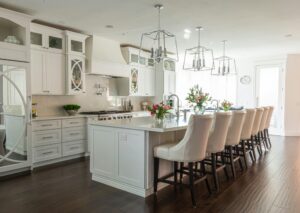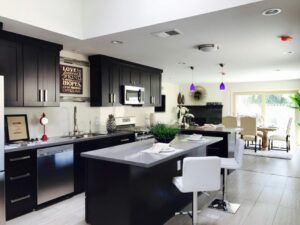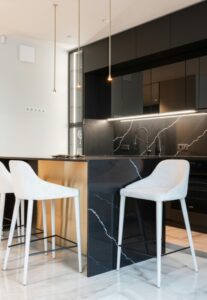Types of Kitchen Hardware
Kitchen hardware plays a critical role in both the functionality and aesthetics of your kitchen. Here, we delve into the different types available.
Cabinet Handles and Knobs
Cabinet handles and knobs are among the most noticeable pieces of hardware in any kitchen. They come in a variety of styles, sizes, shapes, colors, and finishes, allowing you to customize the look of your cabinets and drawers.
Drawer Slides
Drawer slides assist with opening and closing drawers smoothly. There are different designs to choose from, such as side-mount slides or bottom-mount slides, each catering to various needs and preferences.
Hinges
Hinges connect cabinet doors to their frames, allowing for smooth operation when opening or closing them. There are several types, including concealed hinges for a seamless look and soft-close hinges to prevent doors from slamming.
Hooks and Racks
Hooks and racks serve storage purposes, providing extra space for hanging utensils or placing items like spice jars on rack shelves. They help keep the kitchen organized and make frequently used items easily accessible.
Sink & Faucet Hardware
Sink fixtures include faucets that come in diverse designs, offering features like hands-free use, while faucet levers control the water flow rate. These fixtures are crucial for both functionality and style in the kitchen.
Importance of Kitchen Hardware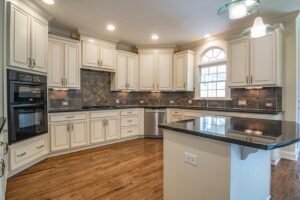
The value that well-chosen kitchen hardware adds goes beyond just looks – it enhances usability too.
Functionality
Hardware provides functional support, making sure every part operates correctly, from drawers sliding out smoothly to cabinet doors swinging open easily. Well-functioning hardware ensures efficiency and convenience in your daily kitchen activities.
Aesthetics
Stylish handles can make all the difference by enhancing the visual appeal, giving your kitchen an elegant and cohesive look. Choosing the right finishes and designs can tie the entire kitchen together, making it a more enjoyable space to work in.
Safety
Properly installed hinges prevent accidental slamming, thereby reducing the chances of finger injuries. Additionally, features like soft-close mechanisms and sturdy handles enhance overall safety in the kitchen.
Choosing The Right Kitchen Hardware
Making wise choices requires considering several factors:
Matching Hardware To Your Kitchen Style
Your choice should complement your overall design theme, whether modern or classic. Consider the color scheme, material finishes, and the general vibe of your kitchen to ensure the hardware fits seamlessly.
Considering The Material
Material quality determines longevity; consider durability over cost savings on cheaper alternatives. Materials like stainless steel, brass, and nickel are popular for their durability and timeless appeal.
Size And Proportions
Size does matter, especially where door pulls must match drawer pull sizes. Bigger isn’t always better! Ensure that the hardware is proportionate to the cabinets and drawers to maintain balance and functionality.
Ease Of Use And Maintenance
Choose user-friendly designs that require little maintenance. Features like ergonomic handles and easy-to-clean finishes can save time and effort in the long run.
Installation Of Kitchen Hardware
A good installation ensures hardware functions effectively and lasts long.
Tools Needed
Here are essential tools required: screwdrivers, measuring tape, drill, level. Having the right tools ensures precise and secure installation.
Step-By-Step Process
The process involves measuring accurately, marking points for screws, drilling holes, then attaching the hardware piece. Follow the manufacturer’s instructions for best results and double-check measurements before drilling.
Safety Precautions
Wear protective gear such as gloves and goggles to prevent injuries. Ensure the work area is well-lit and free of clutter to avoid accidents.
Maintaining Kitchen Hardware
Good care of your kitchen hardware guarantees longevity.
Cleaning And Care
Regular cleaning keeps your kitchen shiny while preventing damage caused by the build-up of grease or dirt. Use appropriate cleaning agents for different materials and avoid abrasive cleaners that can scratch the surfaces.
Regular Checks For Wear And Tear
Check hinges for rusting or loosening bolts which might need replacement. Regular inspections help identify issues early, preventing more significant problems down the line.
When To Replace
Replace worn-out pieces before they cause inconvenience, such as a broken cabinet handle. Timely replacements ensure the kitchen remains functional and safe.
Cost Considerations
Managing cost involves smart planning.
Budgeting For Kitchen Hardware
Plan your spending wisely, factoring in costs like labor charges if hiring professional installers. Set a realistic budget that covers both the purchase and installation of the hardware.
Cost-Saving Tips
Buying in bulk can lead to discounts. Also, consider seasonal sales when prices may be lower than usual. Look for quality items on sale rather than compromising on cheaper, less durable options.
Value For Money
Consider durability over cheaper alternatives, ensuring value for money invested into the kitchen makeover. Quality hardware might have a higher upfront cost but will save money in the long run by lasting longer.
Trends In Kitchen Hardware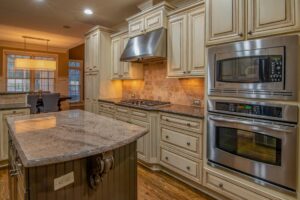
Keeping up with trends can add modernity to an otherwise dated space.
Popular Styles And Designs
Current styles include minimalist handles featuring clean lines, fitting well with contemporary spaces. Matte black, brushed gold, and polished nickel are popular finishes that add a modern touch.
Innovative Features
Hands-free faucets are becoming increasingly popular due to their ease of use, particularly when hands are full. Features like touchless operation and pull-down sprayers add both functionality and convenience.
Sustainability In Kitchen Hardware
More people prefer eco-friendly options such as water-saving faucets or materials made from recycled content. Sustainable choices not only benefit the environment but also appeal to the growing eco-conscious consumer base.
Common Mistakes To Avoid
Avoid mistakes commonly made during selection and installation processes.
Incorrect Measurements
Measure twice, cut once; ensure accurate measurements before buying or installing any piece of hardware. Accurate measurements prevent installation issues and ensure a perfect fit.
Overlooking Comfort And Practicality
Choose styles that not only look good but are also comfortable to use and easy to clean. Ergonomic designs and low-maintenance finishes enhance everyday usability.
Neglecting Maintenance
Regular cleaning and timely replacements help maintain functionality. Establish a routine maintenance schedule to keep your kitchen hardware in top condition.
Conclusion: Making The Most Of Your Kitchen Hardware
A well-designed kitchen benefits from carefully chosen, properly installed, and regularly maintained hardware.
Recap Of Key Points
Choosing the right material, matching style with the overall design theme, accurate measurements, and proper installation are key takeaways. Investing in quality pieces ensures longevity and satisfaction.
Final Thoughts And Advice
Invest wisely in quality pieces offering both style and practicality while keeping trends in mind. A well-equipped kitchen not only enhances functionality but also adds value and enjoyment to your home.
FAQs
- Can I install my own kitchen hardware?
- Yes, you can if you have the necessary tools like a drill or screwdriver and follow safety precautions.
- When should I replace my kitchen hardware?
- Consider replacement when they show signs of wear like rusting hinges or loose handles.
- What’s trendy now in terms of kitchen cabinet handles?
- Minimalist designs featuring clean lines are currently popular for contemporary kitchens.
- How often do I need to clean my faucet?
- Weekly cleaning can keep your faucet shiny, preventing the build-up of dirt which may damage it over time.
Contents
